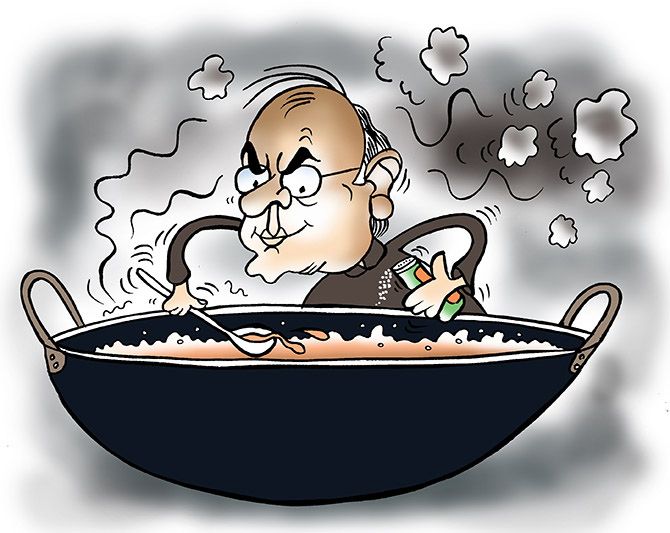For the first time in the history of Budget-making in India, a single Budget will touch 65 crore Indians, virtually the entire voting population, says Shailesh Haribhakti.
Illustration: Uttam Ghosh/Rediff.com

This is a brilliant political, economic statement of intent.
Rural India will receive 5.15 million homes, 20 million toilets, 300,000 km of roads and fully-exempt FPOs (Farmer Producer Organisations).
Digitisation will fully embrace the entire rural marketing chain, ie, from farm to fork, by connecting all APMCs to the internet; 1.5 times of input costs will flow back as MSP to the farmers creating massive purchasing power in rural areas.
Consumption, which underpins India’s phenomenal GDP growth, will take flight. All this, plus a ModiCare (MC), which will touch a 10 crore families at the bottom of the pyramid, will help create the biggest transformation in “Terms of Trade” between urban and rural India.
For the first time in the history of Budget-making in India, a single Budget will touch 65 crore Indians, virtually the entire voting population.
As political astuteness goes, there cannot be a more game-changing Budget.
In terms of global statesmanship, MC will certainly be larger than Obamacare (OC).
The other major forces that have been unleashed include building on the formalisation of the economy reflected by the increase in the large number of taxpayer population, 34 lakh in indirect taxes and a few million in direct taxes.
No wonder the direct tax growth is more than double the nominal GDP growth.
Institutionalisation will happen through the government directly owning National Housing Bank (NHB), and the establishment of specific funds for fisheries & aquaculture, animal husbandry, horticulture and other rural interventions.
A revolutionary operation, aptly titled “Operation Green”, with a corpus of Rs 500 crore, will make India a net exporter of vegetables in the near future.
Over a 3- to 5-year horizon, this institutionalisation will be game-changing.
Farm incomes will rise by 100 per cent and exports will grow by more than 15 per cent.
Electronification will visit education, particularly rural education.
Analytics will focus attention on sources of tax evasion and without direct interaction between department and assessees, technology will continue to deliver smart multiples of GDP growth as tax growth.
My firm belief is that India’s tax to GDP ratio will grow to 15 per cent in 2020.
The Rs 20,000 crore direct tax effort is entirely from capital gains in the form of a 10 per cent long-term capital gains tax on the transfer of listed equity shares exceeding Rs 100,000 over and above STT already being charged.
This will affect not more than 1 per cent of India’s population and the grandfathering of the applicability of long-term capital gains will buffer the adverse effects in the capital markets.
This is critical to meet the Rs 80,000 crore divestment target and to keep the FDI flows going.
The arbitrage between short and long-term gains will get limited and so the quality of governance will drive market price evolutions.
A summary of some of the direct tax changes is given below:
- Tax exemption for farmer producer companies
- Corporate tax reduced to 25 per cent for companies having a turnover up to Rs 250 crore
- No change in personal tax rates
- Salaried taxpayers get a Standard Deduction of Rs 40,000 in lieu of conveyance and medical expenses
- 10 per cent long-term capital gains tax on the transfer of listed equity shares exceeding Rs 100,000
- Deduction for senior citizens increased to Rs 50,000 for Mediclaim u/s 80D
- Senior citizens’ fixed deposits exempt from TDS up to Rs 20,000
- Senior citizens’ fixed deposit interest exempt from TDS up to Rs 50,000
- Cess on income tax increased from 3 per cent to 4 per cent
The above reliefs do not add up to Rs 20,000 crore.
All in all, a “Robin Hood” Budget.
Shailesh Haribhakti is chairman Haribhakti & Co.











